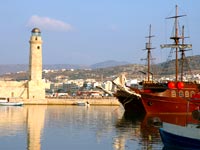 GENERAL INFORMATION about RETHYMNON PREFECTURE
GENERAL INFORMATION about RETHYMNON PREFECTURE

The prefecture of Rethymnon (Rethymno) covers an area of 1,496 sq.km. and is adjacent to the prefectures of Hania and Iraklio. It has approximately 81,000 inhabitants, 23,000 of whom live in the capital of the prefecture, the town of Rethymnon (Rethymno). Other significant towns and villages are Agia Galini, Anogia, Bali, Episkoppi, Perama and Spili.
Rethymnon (Rethymno) is the most mountainous prefecture of Crete with high mountain chains, such as Lefka Ori, Psiloritis (or Ida) and Kouloukounas. The few valleys that have been formed between them are Milopotamos and Amariou valleys. The climate in this part of Crete is very good, although at times rather dry, with sunshine most of the year. The temperature varies between 12 and 27 C.
You can get around the prefecture using either the national highway, running parallel to the north coast, or one of the routes that connect towns and villages. You can rent a car or a motorcycle at various car rentals in the town of Rethymnon (Rethymno) and you can also take the bus to all the significant villages or other parts of Crete.
 HISTORY OF RETHYMNON (Rethymno) PREFECTURE
HISTORY OF RETHYMNON (Rethymno) PREFECTURE
The history of the prefecture of Rethymnon (Rethymno) goes back to the Neolithic Era (3500 - 2800 BC), from where we have the first marks of human presence on the island. Next came the very important Minoan Period (2800 - 1100 BC), with the growth of many settlements.
Rethymnon (Rethymno) showed significant development during the Geometric, Classic and Roman Periods, entering afterwards the Byzantium Years. After being invaded from Arabs, Rethymnon (Rethymno) was finally under the dominion of Venice. The Venetian Era (1204-1669) brought a general Cretan Renaissance, that helped create many important monuments of architecture and the Arts.
The Turkish domination, that came next, affected the development of the entire island and finally led the people to the historic 1821 revolution. The prefecture of Rethymnon (Rethymno) also contributed to the fight against the Germans, when in 1941 the people resisted the invasion of parachutists.
 THE TOWN OF RETHYMNON (Rethymno)
THE TOWN OF RETHYMNON (Rethymno)
The capital of the prefecture, Rethymnon (Rethymno), is a beautiful harbour on the north coast of Crete. It is a picturesque town with traditional as well as modern elements. The old part of the town has maintained an atmosphere that resembles the venetian period and the Turkish occupation.
But, the rest of the areas surrounding the harbour, have also many superb monuments, such as the «Fortezza» Fortress (1573), Lodgia, a monument from the Cretan renaissance, the Rimondi Fountain (rebuilt in 1626), the venetian harbour and many churches and mosques such as Saint Franciscus Church and the Nerantzes, the Veli Passa, the Kara Moussa Passa and the Great Door mosques.
In Rethymnon (Rethymno) you can visit many museums exhibiting various parts of the Cretan and Greek history and art. The Archaeological museum, the Historic and Folklore museum, the Ecclesiastic museum, the Eleni Frantzeskaki Collection and other galleries.
Rethymnon (Rethymno) also hosts many festivities such as the Renaissance Festival, the Crete Wine Festival, the Fishermen's festival and the Carnival of Rethymnon (Rethymno).
 The prefecture of Rethymnon (Rethymno) covers an area of 1,496 sq.km. and is adjacent to the prefectures of Hania and Iraklio. It has approximately 81,000 inhabitants, 23,000 of whom live in the capital of the prefecture, the town of Rethymnon (Rethymno). Other significant towns and villages are Agia Galini, Anogia, Bali, Episkoppi, Perama and Spili.
The prefecture of Rethymnon (Rethymno) covers an area of 1,496 sq.km. and is adjacent to the prefectures of Hania and Iraklio. It has approximately 81,000 inhabitants, 23,000 of whom live in the capital of the prefecture, the town of Rethymnon (Rethymno). Other significant towns and villages are Agia Galini, Anogia, Bali, Episkoppi, Perama and Spili.
